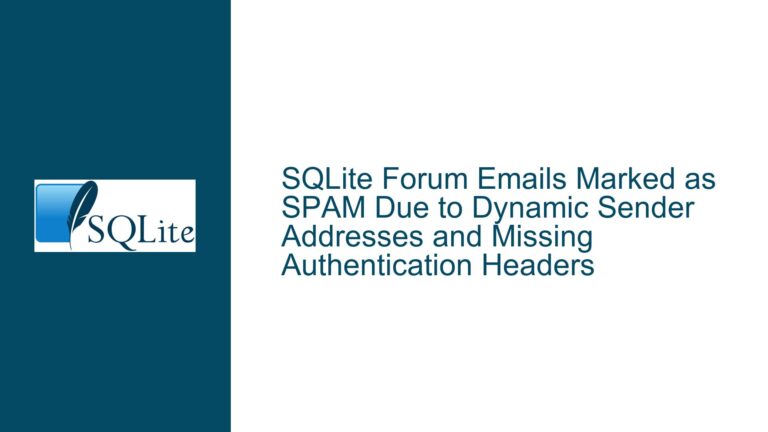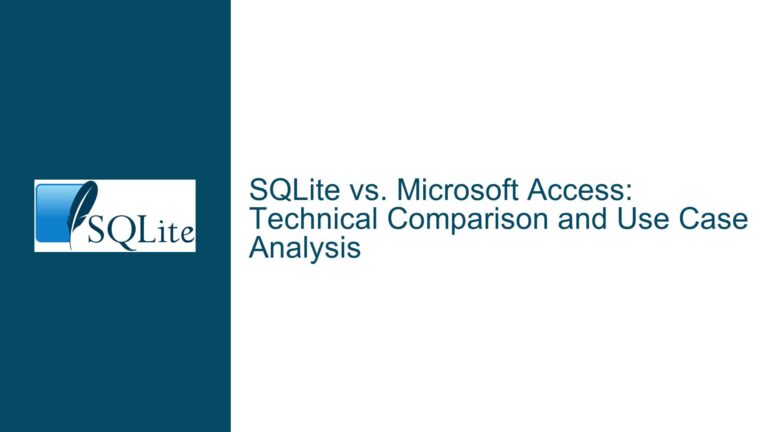Repairing and Recovering Corrupted SQLite Databases with System.Data.SQLite
Understanding SQLite Database Corruption and Recovery Mechanisms
SQLite is a robust, lightweight, and widely-used embedded database engine that is designed to handle data efficiently. However, like any other database system, SQLite databases are not immune to corruption. Corruption can occur due to various reasons, such as hardware failures, software bugs, improper shutdowns, or even file system errors. When a database becomes corrupted, it can lead to data loss, application crashes, or inconsistent states, making it crucial to understand how to detect and repair such issues.
The PRAGMA integrity_check; command is a built-in SQLite feature that allows users to verify the integrity of a database. When executed, this command scans the database for inconsistencies, such as missing pages, invalid indexes, or corrupted data structures, and returns a report of any issues found. However, while PRAGMA integrity_check; is excellent for diagnosing problems, it does not provide a mechanism for repairing the database. This is where the .recover command in the SQLite CLI comes into play.
The .recover command is a powerful tool that attempts to reconstruct a corrupted database by extracting as much data as possible from the damaged file and writing it to a new, clean database file. This process involves reading the corrupted database page by page, identifying valid data, and then rebuilding the database structure in the new file. While this command is highly effective, it is primarily available through the SQLite command-line interface (CLI), leaving developers using System.Data.SQLite wondering how to achieve similar functionality within their applications.
Automatic Recovery Attempts by SQLite and Their Limitations
SQLite is designed to be resilient and includes several built-in mechanisms to handle database corruption automatically. When a corrupted database is accessed, SQLite attempts to recover the database silently in the background. This recovery process involves identifying and isolating corrupted pages, reconstructing valid data, and ensuring that the database can be opened and used without explicit user intervention. If the recovery is successful, the application continues to operate as usual, and the user or developer may never even realize that a problem occurred.
However, this automatic recovery process has its limitations. SQLite’s ability to recover a corrupted database depends on the extent and nature of the corruption. In cases where the corruption is severe or affects critical database structures, SQLite may not be able to recover the database automatically. When this happens, SQLite returns an appropriate error code, indicating that manual intervention is required. This is where tools like the .recover command become essential.
It is important to note that SQLite’s automatic recovery mechanism does not modify the original database file. Instead, it works with the corrupted file in memory, attempting to reconstruct a valid database state. This approach ensures that the original file remains unchanged, preserving the possibility of manual recovery attempts if the automatic process fails. However, this also means that the automatic recovery process does not "repair" the database file in place. To achieve a permanent repair, the recovered data must be written to a new database file.
Manual Database Recovery Using System.Data.SQLite and Best Practices
For developers using System.Data.SQLite, the lack of a direct equivalent to the .recover command can be a challenge. However, there are several approaches to manually recover a corrupted database within this framework. One common method involves using the SQLite CLI to perform the recovery and then integrating the recovered data into the application. This process typically involves the following steps:
Exporting Data from the Corrupted Database: The first step is to use the SQLite CLI to attempt a recovery of the corrupted database. This is done by running the
.recovercommand, which extracts valid data from the corrupted file and writes it to a new database file. The command syntax is as follows:sqlite3 corrupted.db ".recover" | sqlite3 recovered.dbThis command reads the corrupted database (
corrupted.db), attempts to recover the data, and writes the recovered data to a new database file (recovered.db).Importing Recovered Data into the Application: Once the data has been recovered into a new database file, the next step is to integrate this data into the application. This can be done by replacing the corrupted database file with the recovered file or by copying the data from the recovered file into the application’s existing database. The choice of approach depends on the specific requirements and constraints of the application.
Validating the Recovered Data: After recovering the data, it is essential to validate its integrity and consistency. This can be done using the
PRAGMA integrity_check;command on the recovered database file. Additionally, application-specific validation logic may be required to ensure that the recovered data meets the expected business rules and constraints.Implementing Preventive Measures: To minimize the risk of future database corruption, it is important to implement preventive measures. These may include regular database backups, proper error handling, and ensuring that the application and underlying system are configured to handle unexpected shutdowns gracefully. Additionally, monitoring tools can be used to detect and address potential issues before they lead to corruption.
While the above steps provide a general framework for recovering a corrupted database using System.Data.SQLite, it is important to note that the specific implementation details may vary depending on the application’s architecture and requirements. Developers should also be aware of the limitations of the recovery process, particularly in cases where the corruption is extensive or affects critical database structures.
In conclusion, while SQLite provides robust mechanisms for handling database corruption, manual intervention may be required in some cases. By understanding the tools and techniques available, developers can effectively recover corrupted databases and ensure the continued reliability and integrity of their applications.






